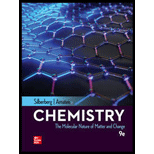
Concept explainers
(a)
Interpretation:
The effect of an increase in temperature on the electrical conductivity of silicon is to be determined.
Concept introduction:
Band theory is a model that defines the energy of the electrons in the solid and determines the conductivity of the solids. It is derived from the theory of the molecular orbital. The lower occupied molecular orbital is known as valence band and higher unoccupied molecular orbital are known as the conduction band. The solids can be classified on the basis of band theory as follows:
1. Conductors.
2. Semiconductor
3. Insulators
A periodic table is an arrangement of elements based on their
(b)
The effect of an increase in temperature on the electrical conductivity of lead is to be determined.
Concept introduction:
Band theory is a model that defines the energy of the electrons in the solid and determines the conductivity of the solids. It is derived from the theory of the molecular orbital. The lower occupied molecular orbital is known as valence band and higher unoccupied molecular orbital are known as the conduction band. The solids can be classified on the basis of band theory as follows:
1. Conductors.
2. Semiconductor
3. Insulators
A periodic table is an arrangement of elements based on their atomic number, properties, and electronic configuration. The table is arranged into groups and periods. The elements which are metallic in nature, occupy the large lower-left portion of the table. The non-metals occupy the small upper-right portion of the table. Metalloids like along the staircase line. Elements which appear in the same group have similar behavior.
(c)
The effect of an increase in temperature on the electrical conductivity of germanium is to be determined.
Concept introduction:
Band theory is a model that defines the energy of the electrons in the solid and determines the conductivity of the solids. It is derived from the theory of the molecular orbital. The lower occupied molecular orbital is known as valence band and higher unoccupied molecular orbital are known as the conduction band. The solids can be classified on the basis of band theory as follows:
1. Conductors.
2. Semiconductor
3. Insulators
A periodic table is an arrangement of elements based on their atomic number, properties, and electronic configuration. The table is arranged into groups and periods. The elements which are metallic in nature, occupy the large lower-left portion of the table. The non-metals occupy the small upper-right portion of the table. Metalloids like along the staircase line. Elements which appear in the same group have similar behavior.
Want to see the full answer?
Check out a sample textbook solution
Chapter 12 Solutions
Chemistry: The Molecular Nature of Matter and Change
- What are the major products of the following reaction? Please provide a detailed explanation and a drawing to show how the reaction proceeds.arrow_forwardWhat are the major products of the following enolate alkylation reaction? Please include a detailed explanation as well as a drawing as to how the reaction proceeds.arrow_forwardA block of zinc has an initial temperature of 94.2 degrees celcius and is immererd in 105 g of water at 21.90 degrees celcius. At thermal equilibrium, the final temperature is 25.20 degrees celcius. What is the mass of the zinc block? Cs(Zn) = 0.390 J/gxdegrees celcius Cs(H2O) = 4.18 J/gx degrees celcusarrow_forward
- Potential Energy (kJ) 1. Consider these three reactions as the elementary steps in the mechanism for a chemical reaction. AH = -950 kJ AH = 575 kJ (i) Cl₂ (g) + Pt (s) 2C1 (g) + Pt (s) Ea = 1550 kJ (ii) Cl (g)+ CO (g) + Pt (s) → CICO (g) + Pt (s) (iii) Cl (g) + CICO (g) → Cl₂CO (g) Ea = 2240 kJ Ea = 2350 kJ AH = -825 kJ 2600 2400 2200 2000 1800 1600 1400 1200 1000 a. Draw the potential energy diagram for the reaction. Label the data points for clarity. The potential energy of the reactants is 600 kJ 800 600 400 200 0 -200- -400 -600- -800- Reaction Progressarrow_forwardCan u help me figure out the reaction mechanisms for these, idk where to even startarrow_forwardHi, I need your help with the drawing, please. I have attached the question along with my lab instructions. Please use the reaction from the lab only, as we are not allowed to use outside sources. Thank you!arrow_forward
- Hi, I need your help i dont know which one to draw please. I’ve attached the question along with my lab instructions. Please use the reaction from the lab only, as we are not allowed to use outside sources. Thank you!arrow_forward5. Write the formation reaction of the following complex compounds from the following reactants: 6. AgNO₃ + K₂CrO₂ + NH₄OH → 7. HgNO₃ + excess KI → 8. Al(NO₃)₃ + excess NaOH →arrow_forwardIndicate whether the product formed in the reaction exhibits tautomerism. If so, draw the structure of the tautomers. CO₂C2H5 + CH3-NH-NH,arrow_forward
- Draw the major product of this reaction N-(cyclohex-1-en-1-yl)-1-(pyrrolidino) reacts with CH2=CHCHO, heat, H3O+arrow_forwardDraw the starting material that would be needed to make this product through an intramolecular Dieckmann reactionarrow_forwardDraw the major product of this reaction. Nitropropane reacts + pent-3-en-2-one reacts with NaOCH2CH3, CH3CHOHarrow_forward
 ChemistryChemistryISBN:9781305957404Author:Steven S. Zumdahl, Susan A. Zumdahl, Donald J. DeCostePublisher:Cengage Learning
ChemistryChemistryISBN:9781305957404Author:Steven S. Zumdahl, Susan A. Zumdahl, Donald J. DeCostePublisher:Cengage Learning ChemistryChemistryISBN:9781259911156Author:Raymond Chang Dr., Jason Overby ProfessorPublisher:McGraw-Hill Education
ChemistryChemistryISBN:9781259911156Author:Raymond Chang Dr., Jason Overby ProfessorPublisher:McGraw-Hill Education Principles of Instrumental AnalysisChemistryISBN:9781305577213Author:Douglas A. Skoog, F. James Holler, Stanley R. CrouchPublisher:Cengage Learning
Principles of Instrumental AnalysisChemistryISBN:9781305577213Author:Douglas A. Skoog, F. James Holler, Stanley R. CrouchPublisher:Cengage Learning Organic ChemistryChemistryISBN:9780078021558Author:Janice Gorzynski Smith Dr.Publisher:McGraw-Hill Education
Organic ChemistryChemistryISBN:9780078021558Author:Janice Gorzynski Smith Dr.Publisher:McGraw-Hill Education Chemistry: Principles and ReactionsChemistryISBN:9781305079373Author:William L. Masterton, Cecile N. HurleyPublisher:Cengage Learning
Chemistry: Principles and ReactionsChemistryISBN:9781305079373Author:William L. Masterton, Cecile N. HurleyPublisher:Cengage Learning Elementary Principles of Chemical Processes, Bind...ChemistryISBN:9781118431221Author:Richard M. Felder, Ronald W. Rousseau, Lisa G. BullardPublisher:WILEY
Elementary Principles of Chemical Processes, Bind...ChemistryISBN:9781118431221Author:Richard M. Felder, Ronald W. Rousseau, Lisa G. BullardPublisher:WILEY





